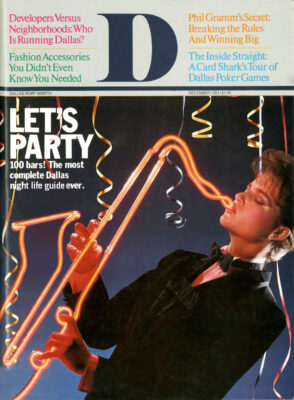ANOTHER LIST of the year’s best records. As unnecessary as another explanation of Mick Jagger, you say. We all know that music writers are imbecilic buffoons, full of bombast and baloney, prone to confuse Foreigner with rock ’n’ roll. Besides, you say, I already know what the best records are, and I’ve already got them. Well, nevertheless, it’s a well-known medical fact that writers must periodically make up lists in order to purge themselves of basically useless bits of information that can choke them up and prevent more sensible works. Therefore, whether you want it or not, here’s the year’s Top 10 albums (pop category) with some tail-end of 1980 slippage.
Face Dances. The Who (Warner Brothers): The Who has been around awhile, but, just like the Stones, hasn’t mellowed. Peter Townshend’s intelligent, frequently cockeyed and always cocksure songs are top-of-the-line, and Roger Daltry’s damnthe-consequences delivery is bang-on. The general tone of “Face Dances” can be summed up with these lines by Town-shend: “I showed up late one night with a neon light for a visa/But knowing I’m so eager to fight can’t make letting me in any easier/I know that I been wearing crazy clothes and look pretty crappy sometime/ But my body feels good and I still sing a razor line every time.” “Face Dances” is as meaty, beaty and bouncy as anything The Who has ever done.
The Live Album. Leon Russell and Newgrass Revival (Paradise): On the white side of Ray Charles, there are a half-dozen or so vocalists around with pure honest soul -Gregg Allman, Delaney Bramlett, Eric Clapton, Russell Smith and Leon Russell. When you add Leon’s varied musical background to his soul, you get a combination that makes for music that’s always interesting and always soulful. Leon’s been around long enough to absorb a lot of musical influences – pure mountain bluegrass to Texas honky-tonk. The Newgrass Revival is an adventuresome, virtuostic quartet whose problem has always been one of focus: They’re so intent on showing their prowess that they lose their direction. With Russell providing the target, Sam Bush and company zero in, and the result is eccentric, innovative and interesting. Consider: “Jumpin’ Jack Flash” done bluegrass.
How the Hell Do You Spell Rythum? The Amazing Rhythm Aces (Warner Brothers): This album, by one of the best yet most ignored groups of the decade, turned out to be its swan song. After “How the Hell” failed to make chart headway, the band split, declaring that since no one cared, they had decided to seek other avenues. A few years back the Aces hit the charts with two excellent singles, “Third Rate Romance” and “The End Is Not in Sight.” The latter, an intelligent rendition of the “What Does It All Mean?” question, won a Grammy. Like that of the All-man Brothers, the Aces’ music is a direct reflection of their Southern roadhouse roots. They teethed in the fightin’ and dancin’ bars -the places where the band book has to include everything from Hank Williams to Neil Diamond and the band look is baby-blue tuxedos. But where the Allmans were the fighting side of the roadhouses, the Aces were the dancing side. This record is a splendid example of their work: Too-much-booze vocals by Russell Smith; waltzing Hammond-organ lines by Billy Earheart; clean, on-the-nose guitar by Duncan Cameron; rocking piano by James Hooker.
Tattoo You. The Rolling Stones (Atlantic): Music’s leading practitioners of wild-eyed hedonism, Mick Jagger, Keith Richards and company returned in 1981 with their best effort since “Some Girls.” Smart and smart-ass, nasty and nihilistic, the Stones don’t mature or mellow. They’re still out there looking for bigger rocks to toss in the face of conventionality. Jagger doesn’t just deliver a line, he rubs your face in it. Rock ’n’ roll has always depended on a good healthy helping of evil for its energy, and the Stones have taken that basic evil and added that special English sophistication (it’s not without reason that among sex-game aficionados “English culture” means bondage and discipline). It’s a stylized evil, but Jagger and Richards and their respective mystiques make it all believable.
Pirates. Rickie Lee Jones (Warner Brothers): Ms. Jones’ second album is just as fresh as her first. She manages, in both her writing and in her singing, to exude a magical combination: at once tough and vulnerable. She’s well-versed musically and can range over the entire musical map. But she also understands that everything must work for a common end; there’s nothing extraneous in any song. The subjects are urban variations on love and ambition; the images are blind-alley dark: “But a sailor just takes a broad down/to the dark end of the fair/to turn her into a tattoo.” Or “And I can hear him in every footstep’s passing sigh/he goes crazy these nights/watching heartbeats go by.” Ms. Jones matches her lyrics with darting, swooping music, and the result is a streetwise stance coupled with a kind of little-girl innocence. It’s like a 6-year-old dressing up in her mother’s clothes, and it can be devastating.
Borderline. Ry Cooder (Warner Brothers): Cooder’s latest is included in this list not because it’s anything special, but because it is like all his other records: It is interesting musically and is technically beautiful. It contains several different examples of several different musical styles, all performed flawlessly. Cooder is at his best when he’s having fun with the lyrics, and the best cut here is the sly “Girls from Texas” with its tongue-in-cheek look at Lone Star females. Cooder is a musicologist, always learning new things, and we’re privileged that he lets us in on his discoveries.
It Ain’t What You Eat It’s the Way How You Chew It. Sleepy LaBeef (Rounder): This is the eccentric entry. LaBeef, for those unfamiliar with him, is an Arkansas native, a rockabilly-era bandleader who has absorbed more styles than there are ingredients in gumbo. On this record are examples of gospel, country, blues, zydeco, rockabilly and plain old rock. LaBeef stands 6-foot-6 and possesses a furnace-fire voice. He moves from commanding to demanding when he’s singing, and he knows what each style and each song requires for success. Throughout there’s a feeling of impending mayhem, barely in check and threatening to break loose at any time. LaBeef’s recording efforts are not easy to find, but the reward is well worth the search.
The South Coast of Texas. Guy Clark (Warner Brothers): Clark is one of the last unspoiled kick-ass country artists around. His range is wide -bluegrass to Austin outlaw -and he takes backsaddle to no one in the country-poet field: “She’s a reason to be reckless/she’s a right to rock ’n’ roll/she’s exactly what they meant/ when they told you not to go.” Clark has a reputation as a hell-raiser, and he delivers like it’s not all hype. When he sings about honky-tonks and brawls and two-timing women, it’s with conviction.
Arc of a Diver. Steve Winwood (Island): Winwood’s mixture -old English folk, rock and jazz coupled with thoughtful, mystical lyrics -has always produced great songs. He’s a master of looping melodies, and he’s always pushing out his edges, enveloping more diverse influences. There’s a bit of mid-life resignation to “Arc” (not odd when you consider that Winwood started his musical career as a teen-ager in the Spencer Davis Group), but it’s gentle and bemused, a resignation without bitterness. “Arc of a Diver” is superb.
Autoamerican. Blondie (Chrysalis): Now that Blondie has grown up, the band has turned into one of America’s best, at once innovative and reflective of our pop culture. The band has slid through the mindlessness of disco and the self-destruc-tiveness of punk and come up with a true survivor’s viewpoint of what the middle and late Seventies were all about. Deborah Harry is a vocalist of considerable versatility: speak-easy campy in “Here’s Looking at You,” tough in “Live It Up” and dynamite on “Faces.” The latter, in fact, is the best cut by a female vocalist I’ve heard in quite a while. It’s a jazzy, evocative slow-burner that consumes everything – complete and totally satisfying.
The other stack: a list of albums that were close, but didn’t quite make the Top 10 collection.
Another Ticket. Eric Clapton (RSO): For the most part, “Ticket” is a sparkling effort worthy of the man once referred to as God by a collection of guitarists, but it’s not quite as energetic as it should be.
El Rayo-X. David Lindley (Asylum): Lindley, late of the old Kaleidoscope, has a nice warped viewpoint and good chops, but this record is a little too weighted toward old rock ’n’ roll.
Shot of Love. Bob Dylan (Columbia): The master’s religious turn hasn’t hurt his music too much as far as I’m concerned, but there’s a bit too much derivation (of older Dylan) on this record for it to be completely successful.
King Bee. Muddy Waters (Blue Sky): Waters, one of the seminal figures in blues – and therefore, in rock – is still producing excellent blues, wedding country style with the urban energy that he helped introduce and that his dozens of followers helped develop.
Jumpin’ Jive. Joe Jackson (A&M): English rocker Jackson has dipped into America’s musical past for a helping of old Louis Jordan -“Five Guys Named Moe,” “What’s the Use of Getting Sober”-and brought out a dynamic and high-kicking collection.
Butt Rockin’. The Fabulous Thunder-birds (Chrysalis): This blues revival group is one of the tightest around, and the members are not afraid to step out into some of the more adventuresome offshoots of the genre.
Restless Eyes. Janis Ian (Columbia): Ms. Ian is one of rock’s better constants; she has never disappointed, and she doesn’t here, either: intelligent looks at life perfectly executed.
Borned with the Blues & Raised on Rock ’n’ Roll. Kenny Wayne (Amazing): Texan Wayne has a rough and ready voice, excellent taste in material and a genuine feel for the blues. The result: straight up, no-jive good times. He gets plenty of help from some of Texas’ best blues musicians: Bugs Henderson, Anson Funder-burgh, the Juke Jumpers and Smokin’ Joe Kubek.
Get our weekly recap
Brings new meaning to the phrase Sunday Funday. No spam, ever.
Related Articles

Arts & Entertainment
‘The Trouble is You Think You Have Time’: Paul Levatino on Bastards of Soul
A Q&A with the music-industry veteran and first-time feature director about his new documentary and the loss of a friend.
By Zac Crain

Things to Do in Dallas
Things To Do in Dallas This Weekend
How to enjoy local arts, music, culture, food, fitness, and more all week long in Dallas.
By Bethany Erickson and Zoe Roberts

Local News
Mayor Eric Johnson’s Revisionist History
In February, several of the mayor's colleagues cited the fractured relationship between City Manager T.C. Broadnax and Johnson as a reason for the city's chief executive to resign. The mayor is now peddling a different narrative.


